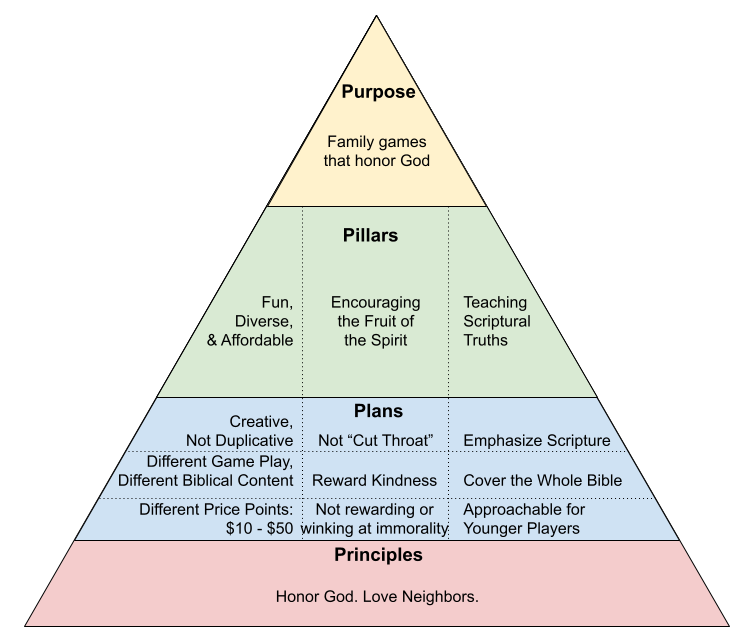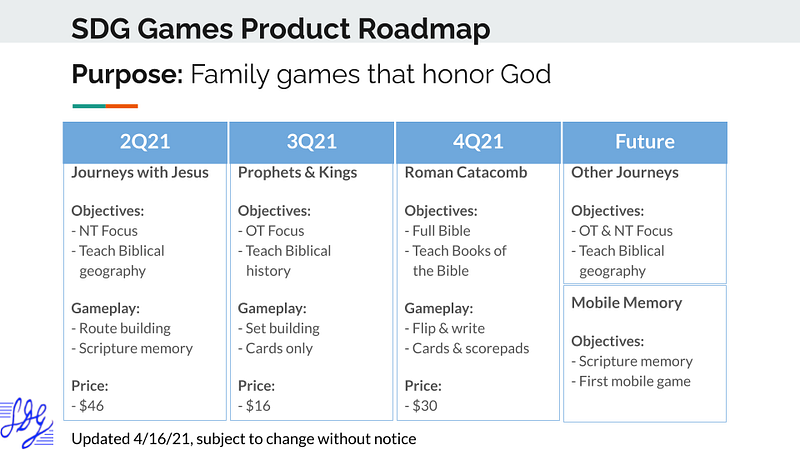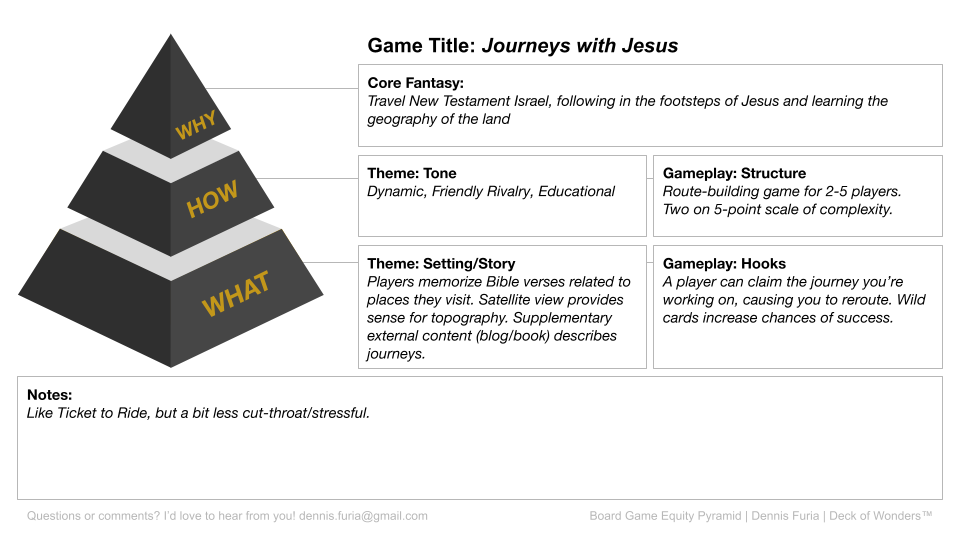As we continue moving through the strategic startup journey for SDG Games, we have come to the point where we really need to formally define our initial product and to set a draft product strategy and roadmap. I will deal with these topics as three separate elements: initial product definition, product strategy, and product roadmap.
Initial Product Definition
The first product to be released by SDG Games is Journeys with Jesus, a route-building board game. As with most board games (and other consumer products), the product is fairly well self-encapsulated. Customer interaction is minimal and add-on services are difficult to envision or deliver.
That being said, one somewhat unique aspect of the product definition is the development of additional external content. The game involves completing 23 journeys taken by Jesus in the gospel accounts. We have already begun writing blog posts describing those journeys as an additional way for players to engage with the game and to further learn about the geography of the Bible. We anticipate potentially publishing these articles in book form as a supplementary product once they are complete.
Dennis Furia, a corporate brand strategist turned game designer, has recently introduced the Board Game Equity Pyramid as a tool for game designers to define the essence of their game, both to ensure they hit the target during development and to effectively communicate the value of the product in marketing efforts.
In many ways, the tool is similar to the Messaging Pyramid and Purpose Pyramid I use in my strategy work. I like Dennis’ linkage of Simon Sinek’s “golden circle” (why-how-what) to the three levels of the pyramid. That is consistent with how I use the Messaging and Purpose Pyramids and will help me in describing those tools to clients in the future. However, the Equity Pyramid doesn’t follow the same structure (e.g. 1 purpose — 3 pillars — 9 plans) as the tools I use. Instead, Dennis breaks the second layer into two parts: Theme and Gameplay and then the third level provides greater detail on these two key elements. I think this works well for board games.
So, here’s the Board Game Equity Pyramid for Journeys with Jesus (using Dennis’ template):

Product Strategy
Up to now, our entire focus has been on Journeys with Jesus. Now it’s time to think beyond this initial product and consider what comes next — when, why, and how. Before we can begin planning a product roadmap, we need to define a strategy that will help make product and timing decisions easier. Here is the Product Strategy for SDG Games:

Note that this cascades off of the SDG Games business strategy. The middle pillar of that strategy was “develop family games that honor God.” The three plans under that pillar in the business strategy (be creative, encourage fruit of the Spirit, reflect Biblical morality) hint at the pillars in this product strategy, but the pillars of our product strategy need to be more directive and expansive.
The first pillar (fun, diverse, and affordable) captures the requirements for building a successful game business. People won’t play (or buy) games that aren’t fun. Given our target market, we know that not everyone in this market will like the same kinds of games, so diversity will be key. We also know that, especially in the Christian homeschool market, budgets are limited, so we need to focus on affordability.
The second pillar (encouraging the fruit of the Spirit) is an essential element of developing games that will honor God. In Galatians chapter 5, Paul contrasts “the works of the flesh” with the “fruit of the Spirit”. He lists examples of the kinds of immoral behavior that are the works of the flesh and then he lists nine attributes that are the fruit of the Spirit: love, joy, peace, patience, kindness, goodness, faithfulness, gentleness, and self-control. While competitive games naturally involve some level of rivalry, we need to avoid the kinds of “cut throat” game play that are in conflict with love, joy and peace and instead seek game play that rewards patience, kindness, goodness, faithfulness, gentleness, and self-control. It likely will be one of our greatest challenges to develop games that engage players’ competitive spirit and yet reward love and kindness.
Finally, teaching scriptural truths is a key to our purpose of developing games that honor God, especially for our target market of Christian families seeking to teach their kids Biblical truths. Scripture needs to be a core element of every game we develop, we would like to cover the whole Bible over time, and we need to find ways to integrate scripture that are engaging to players of all ages.
I believe that if we are successful with these three pillars, we should have the best opportunity to accomplish the purpose of our product strategy.
Product Roadmap
With that strategy in mind, we can start to lay out a hypothetical timeline of game releases. We will need to test and refine this roadmap over time, but this establishes an initial baseline roadmap.
In the book Product Roadmaps Relaunched¹, C. Todd Lombardo, Bruce McCarthy, Evan Ryan, and Michael Connors identify 5 primary components of a product roadmap:
- Product Vision: The benefit from the product when fully realized.
- Business Objectives: What goals will the product accomplish.
- Timeframes: Broad ranges to explain prioritization and to manage expectations.
- Themes: What needs to be true for the product to realize its vision and obtain the business objectives.
- Disclaimer: Clarifies that everything in the roadmap is subject to change.
Product roadmaps can take many forms to fit the culture, style, and needs of the organization, as long as they present the key elements required for an effective product strategy.
Here is the current product roadmap for SDG Games:

As with any startup, I expect much will change as we move forward, but this gives us a sense of what to work on, when, and with what goals in mind.
Sources:
¹Lombardo, C. Todd, Bruce McCarthy, Evan Ryan, and Michael Connors,. Product Roadmaps Relaunched: How to Set Direction while Embracing Uncertainty. Sebastopol, CA: O’Reilly Media, 2018.

